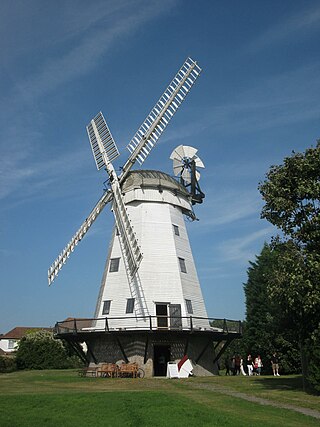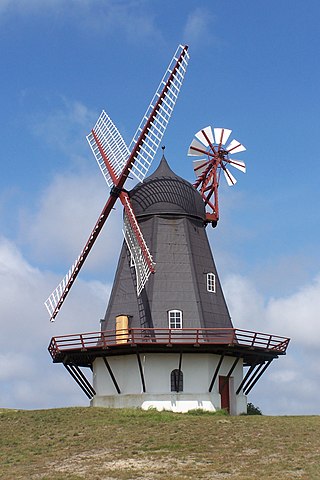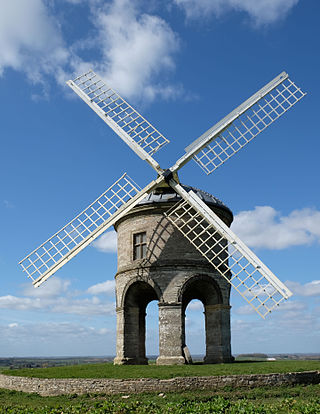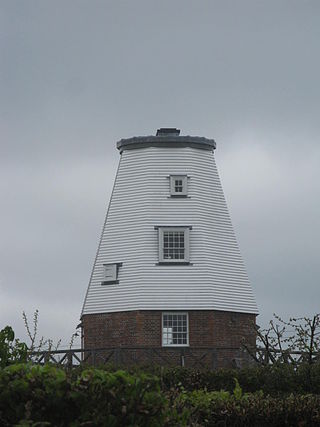
A windmill is a structure that converts wind power into rotational energy using vanes called sails or blades, by tradition specifically to mill grain (gristmills), but in some parts of the English-speaking world the term has also been extended to encompass windpumps, wind turbines, and other applications. The term wind engine is also sometimes used to describe such devices.

Upminster Windmill is a Grade II* listed smock mill located in Upminster in the London Borough of Havering, England. It was formerly known as Abraham's Mill and was in Essex when built. It has been restored and is a museum open to the public at selected times.

Maud Foster Windmill is a seven-storey, five sail windmill located by the Maud Foster Drain in Skirbeck, Boston, Lincolnshire, from which she is named. She is one of the largest operating windmills in England being 80 feet (24.38 m) tall to the cap ball.

Outwood Windmill is a Grade I listed post mill in Outwood, Surrey. Built in 1665 by Thomas Budgen, a miller from Nutfield in Surrey, it is Britain's oldest working windmill.

The smock mill is a type of windmill that consists of a sloping, horizontally weatherboarded, thatched, or shingled tower, usually with six or eight sides. It is topped with a roof or cap that rotates to bring the sails into the wind. This type of windmill got its name from its resemblance to smocks worn by farmers in an earlier period.

Chesterton Windmill is a 17th-century cylindric stone tower windmill with an arched base, located outside the village of Chesterton, Warwickshire. It is a Grade I listed building and a striking landmark in south-east Warwickshire.

Shirley Windmill is a Grade II listed tower mill in Shirley, in the London Borough of Croydon, England which has been restored to working order.

The Nantucket Historic District is a National Historic Landmark District that encompasses the entire island of Nantucket, Massachusetts. The original December 13, 1966 listing on the National Register of Historic Places included only the historic downtown core and the village of Siasconset, but was expanded in 1975 to include the entire island, as well as the islands of Tuckernuck and Muskeget. At over 30,000 acres, it is the largest conventional historic National Historic Landmark District by area in the contiguous United States.

Caston Tower Windmill is a grade II* listed tower mill at Caston, Norfolk, England which is under restoration. The mill is also a scheduled monument.

The Fabyan Windmill is an authentic, working Dutch windmill dating from the 1850s located in Geneva, Kane County, Illinois, just north of Batavia, Illinois, off Illinois Route 25. The five-story wooden smock mill with a stage, which stands 68 feet (21 m) tall, sits upon the onetime estate of Colonel George Fabyan, but is now part of the Kane County Forest Preserve District.

The River Stour has been used for centuries as a source of power. Many different processes were performed by the use of water power:- Corn milling, fulling, paper making and electricity generation. Many of the mills survive today as house conversions, with two of them still working commercially.

Beacon Mill is a Grade II listed smock mill in Benenden, Kent, England which is in need of restoration. The mill has been out of use since 1923 and is privately owned.

Herne Windmill is a Grade I listed smock mill in Herne, Kent, England, that was built in 1789.

Terling Windmill is a grade II listed Smock mill at Terling, Essex, England, which has been converted to residential use.

South Ockendon Windmill was a Smock mill at South Ockendon, Essex, England which collapsed on 2 November 1977.

Bardwell Mill is a Grade II* listed tower mill at Bardwell, Suffolk, England, which is under restoration.

Thelnetham Windmill, also known as Button's Mill is a Grade II* listed tower mill constructed of brick. The windmill is located at Thelnetham, Suffolk, England. It was built in the early nineteenth century to grind wheat into flour. Thelnetham windmill worked by wind power until 1924, latterly on two sails, after which it became derelict.

Cromer Windmill, restored in four stages between 1967 and 1998, is a Grade II* listed post mill at Cromer, Ardeley, Hertfordshire, England.

Garboldisham Mill is a Grade II* listed post mill at Garboldisham, Norfolk, that has been restored.

The Judah Baker Windmill is an 18th-century windmill in South Yarmouth, Massachusetts. It was named after its original builder, Judah Baker, who constructed the mill in 1791. Like many Cape Cod windmills, the windmill experienced several moves before moving to its current location at 89 River Street in Bass River, located within the Historic District of South Yarmouth.




















